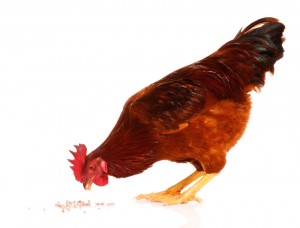Martin O’Malley, Maryland’s governor, signed a bill on May 22, 2012 banning arsenic in poultry feed. Maryland is the first state in the country to ban this practice. The law takes effect January 1, 2013.
 HB 167 prohibits a person from “using, selling, or distributing specified commercial feed intended for use as poultry feed that contains roxarsone or any other additive that contains arsenic.”
HB 167 prohibits a person from “using, selling, or distributing specified commercial feed intended for use as poultry feed that contains roxarsone or any other additive that contains arsenic.”
Roxarsone is also known as 3-Nitro®. It was sold by a subsidiary of Pfizer called Alpharma and was used to prevent coccidiosis, a parasite poultry disease. The drug was also used for weight gain, feed efficiency, and improved pigmentation.
Roxarsone was first approved for use in 1944. At that time, scientists believed that organic arsenic would be excreted as organic arsenic. But new evidence has found that animals transform organic arsenic into inorganic arsenic. Under the Delaney Clause, the FDA cannot approve any compound used in food-producing animals which creates metabolites that are carcinogenic.
In June 2011, Alpharma discontinued sales of the product after an FDA study found inorganic arsenic at higher levels in chickens treated with the compound. While chicken producers say that organic arsenic is used in chicken feed, inorganic arsenic was still found in the birds.
Arsenic is a known human carcinogen. While arsenic is found naturally in the environment, inorganic arsenic is more harmful to human health. Exposure to inorganic arsenic over time can lead to cancer of the lungs, skin, bladder, kidney, liver, and prostate and can cause heart disease and neurological problems.
The levels of inorganic arsenic found in the chickens were very low, according to the FDA, and “continuing to eat chicken as 3-Nitro® is suspended from the market does not pose a health risk.”
The European Union has banned arsenic products in poultry feed and has a zero-tolerance level for arsenic in raw chicken. The FDA set “safe” levels for arsenic in chicken in 1951 and has not changed that level, even though poultry consumption in the U.S. has tripled since that time.
Food and Water Watch, a nonprofit group, says that arsenic in chicken flesh isn’t the only issue; it’s also excreted by the birds. And that waste is used to fertilize farm fields. Like all fertilizer, it eventually ends up in our waterways. And organic arsenic in the waste breaks down into inorganic arsenic. That organization wants to see a ban on arsenical feed additives and drugs.




